
By Brack Johnson
Paleo? Gluten–free? Jenny Craig? Low–fat? Low–carb? Atkins? Ornish? Mediterranean? Flexitarian? There seems to be one diet for every day of the year.
So, Carolina Woman's just not going there.
- Instead, we're looking for main–dish recipes that offer these healthy qualities:
- Freshness to excite the palate
- Robust use of herbs and spices
- Lots of fruit and vegetables
- No added fat other than oil for cooking
- Easy ways to adjust ingredient amounts
And we found them! All over the world. From our neighbors to the north and south – Canada and Mexico – to Asia (bibimbap from Korea) to Europe (gravlax from Norway and farinata from Italy), to Africa (lamb and fish dishes from Morocco), these recipes bring original tastes to the table.
There's lots of fish and produce. Plus, there are methods to take further steps to ensure healthier plates.
Consider, for instance, the Mexican food in "To Cook Is to Love." To make pork fricassee there are two suggestions. One: Cook it the day before and pop it in the fridge overnight. Why? The fat, which rises to the top, can be trimmed off the dish. Two: Delete all or half of the chorizo and green olives.
Flexibility works in these recipes. Your alterations can be big or small. Add some more fruit; throw in a lot more veggies. Reduce the salt; load on the spices. Cut back on the oil in the pan; use cooking spray instead.
Which brings us back to the Carolina Woman philosophy: moderation in all things food. After all, if it doesn't taste good, everyone will be back in McDonald's by February.
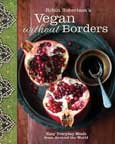 Vegan Without Borders
Vegan Without Borders
Easy Everyday Meals
From Around the World
Robin Robertson
Andrews McMeel
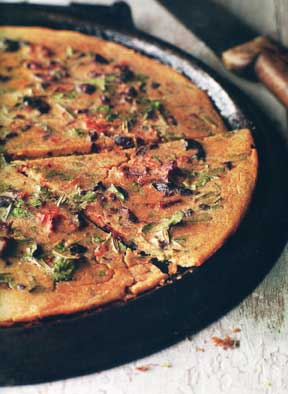 Farinata With Sun–Dried Tomatoes
and Olives
Farinata With Sun–Dried Tomatoes
and Olives
1 cup water
1 cup chickpea flour
2 tablespoons plus 1 teaspoon olive oil
1/2 teaspoon salt
Freshly ground black pepper
3 tablespoons minced kalamata olives
3 tablespoons minced sun–dried tomatoes
In a mixing bowl, whisk together the water and chickpea flour until smooth. Add the oil, salt, a few grinds of pepper, olives and tomatoes, and mix until well blended. Cover and set aside at room temperature for 1 hour.
Preheat the oven to 425 degrees. Oil a 12–inch pizza pan and heat in the oven until hot. Carefully remove the pan from the oven and add the batter, spreading evenly. Bake until the top is firm and the edges are golden brown, about 15 minutes. Cut into thin wedges and serve immediately.
Variation: Omit the olives and tomatoes from the batter and spread the baked farinata with a thin layer of pesto.
Makes 6 servings
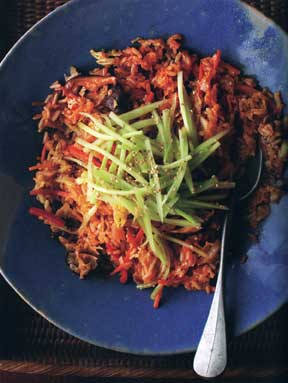 Bibimbap
Bibimbap
3 tablespoons gochujang
paste (Korean chili paste)
1 tablespoon soy sauce
1 teaspoon rice vinegar
1 teaspoon agave nectar
1 tablespoon grapeseed oil
or other neutral oil
1 large yellow onion, chopped
1 red bell pepper, seeded
and cut into matchsticks
2 cloves garlic, minced
3 cups shredded green
cabbage
1 carrot, coarsely shredded
1 cup thinly sliced white
or shiitake mushrooms
3 cups cooked brown rice
1/2 English cucumber, peeled and cut into matchsticks
1 tablespoon toasted sesame seeds
In a bowl, combine the gochujang paste, soy sauce, sesame oil, vinegar and agave. Stir to mix well. Set aside.
Heat the grapeseed oil in a large skillet or wok over medium–high heat. Add the onion, bell pepper and garlic, and stir–fry for 2 minutes. Add the cabbage and carrots and stir–fry for 2 minutes longer. Stir in the mushrooms and stir–fry for 1 minute, then add the reserved sauce and cook, stirring to coat. Add the cooked rice and cook, stirring, until well mixed and heated through.
To serve, spoon the rice and vegetable mixture into bowls and top with cucumber and sesame seeds. Serve extra gochujang sauce and soy sauce on the side.
Makes 4 servings
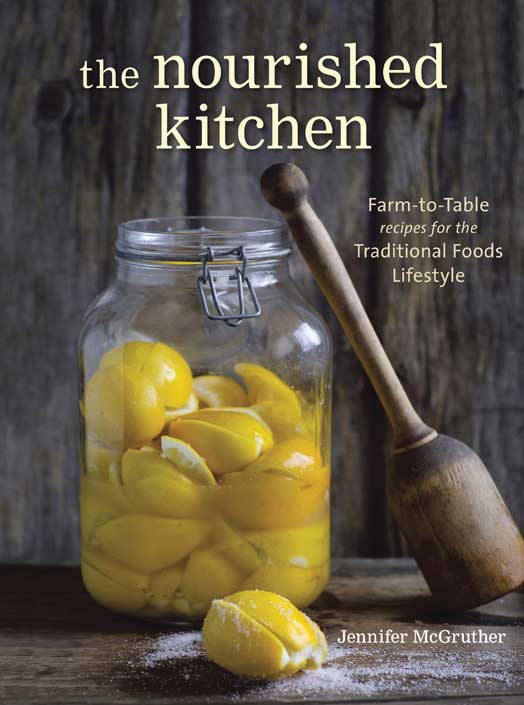 The Nourished Kitchen
The Nourished Kitchen
Farm–to–Table Recipes for the Traditional Foods Lifestyle
Jennifer McGruther
Ten Speed Press
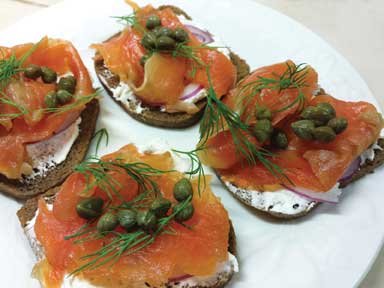 Gravlax With Maple, Dill and Juniper
Gravlax With Maple, Dill and Juniper
1/2 cup coarse unrefined sea salt
1/2 cup maple sugar
2 tablespoons chopped fresh dill
2 tablespoons crushed juniper berries
2 (8–ounce) skin–on wild–caught salmon fillets
Stir together the salt, sugar, dill and juniper berries.
Spread a 14–inch piece of cheesecloth on your countertop, and then lay one salmon fillet flesh side up on the waiting cloth. Pour half the salt mixture over the fish and sandwich the other fillet, flesh side down, on top of the first.
Season the outside of the salmon fillets with the remaining salt mixture and wrap the sandwiched fillets in the cheesecloth as tightly as you can.
Place the wrapped salmon in a resealable plastic bag and set the bag on a plate. Place a second plate over the first to weigh down the fish and refrigerate. Turn the bag once a day for 3 days.
After 3 days, remove the fish from the plastic bag and unwrap the cheesecloth. Brush off the curing mixture from the fish, then pat the fillets dry with a clean kitchen towel.
The gravlax will keep in the fridge in an airtight container for about 1 week before its flavor begins to suffer. Slice it very thinly, as needed, just before serving.
Makes 2–3 servings
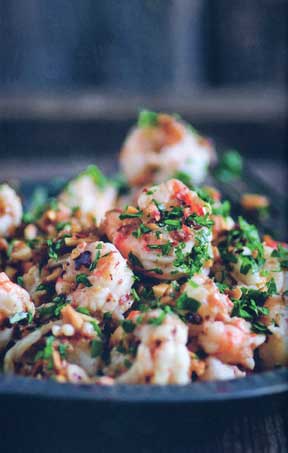 Spot Prawns
With Almonds and Garlic
Spot Prawns
With Almonds and Garlic
1 lemon
1/2 cup coarsely chopped blanched almonds
1/4 cup olive oil
2 cloves garlic, finely chopped
1/4 teaspoon crushed red pepper flakes
2 pounds spot prawns (or shrimp), shelled and deveined
2 tablespoons chopped fresh flat–leaf parsley
Grate the zest of the lemon very finely and place it in a small bowl, then cut the lemon in half crosswise and squeeze its juice into a separate bowl.
Warm a large cast–iron skillet over medium–high heat. Toss in the almonds and toast them, stirring frequently, until they begin to brown just a bit at the edges, about 4 minutes.
Stir the olive oil, garlic, red pepper flakes and lemon zest into the skillet with the almonds. Stir continuously until the garlic softens and becomes fragrant, about 4 minutes.
Toss in the spot prawns and sauté unti they curl and become opaque, about 3 minutes. Stir in the lemon juice and parsley. Serve warm.
Makes 4 to 6 servings
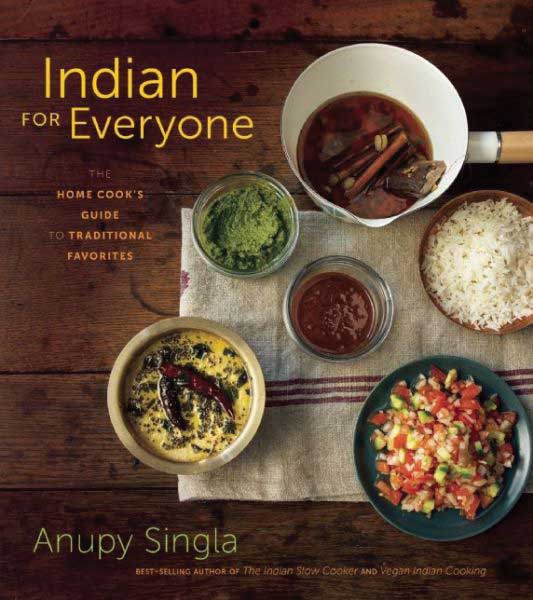 Indian for Everyone
Indian for Everyone
The Home Cook's Guide to Traditional Favorites
Anupy Singla
Surry Books
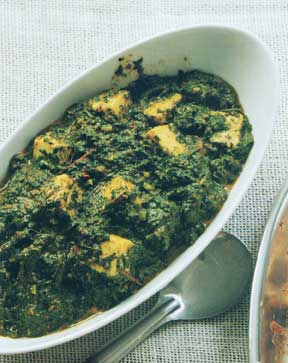 Palak Aloo (Spinach and Potatoes)
Palak Aloo (Spinach and Potatoes)
2 tablespoons ghee or vegetable oil
1 teaspoon cumin seeds
1/2 cup minced yellow or red onion
1–1/2 teaspoons plus 1 pinch salt, divided
1 (1–inch) piece ginger, peeled and grated
3 cloves garlic, peeled and minced
12 small red potatoes with skin, each chopped in 8 pieces
1 teaspoon turmeric powder
1 teaspoon Garam Masala (recipe follows)
1 teaspoon red chile powder or cayenne pepper
8 ounces fresh or frozen spinach, chopped (should yield 4 cups)
1–2 fresh Thai, Serrano or cayenne chiles, stems removed and thinly sliced
1 tablespoon water (optional)
Brown or white basmati rice, Roti, or Naan for serving
In a heavy–bottomed, 4–quart sauté pan over medium–high heat, warm the ghee. Add the cumin seeds and cook for 40 seconds, until the cumin seeds sizzle and turn reddish–brown.
Add the onion and the pinch of salt to the sauté pan and cook for 1 minute, until the onion has slightly browned and is opaque. Add the ginger and garlic and cook for 4 minutes, until the mixture is browned. You'll want to be sure to mix this as it cooks so that it does not stick to the bottom of the pan. If it starts to stick, just add a little water about a teaspoon at a time. You don't want to add too much.
Add the potatoes to the sauté pan and cook, stirring well for 2 minutes, until cooked through. Add the turmeric, Garam Masala, and red chile powder. Stir well and cook for 1 minute.
Add the spinach, the remaining 1–1/2 teaspoons of salt and the fresh chiles to the sauté pan. Stir well and cook for 2 to 3 minutes. If the vegetables start to stick to the pan, add the water.
Raise the heat to high and cook for 2 minutes to remove any excess moisture.
Reduce the heat to low, cover, and cook for 20 minutes, until the potatoes are soft. Remove from the heat. Stir well.
Transfer to a serving bowl and serve immediately with the brown or white basmati rice, Roti or Naan.
Makes 3 cups
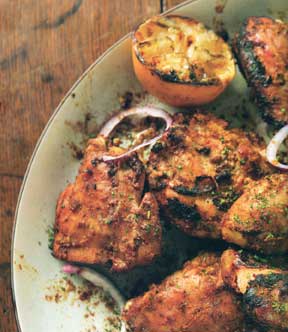 Tandoori Chicken
Tandoori Chicken
1 cup ginger, peeled
and coarsely chopped
1 cup peeled garlic cloves
1–1/2 cups plain, unsweetened yogurt
3 tablespoons Tandoori Masala
(recipe follows)
2 tablespoons salt
1 tablespoon red chile powder
or cayenne pepper
1 teaspoon Garam Masala (recipe
follows), plus more for sprinkling
4 pounds skinless whole bone–in
chicken, cut into 8–10 pieces (including cutting each breast in half), or 2 pounds boneless chicken
1/2 lemon, for squeezing
Thinly sliced onion, for garnish
Chopped fresh cilantro, for garnish
Brown or white basmati rice, Roti or Naan, for serving
In the bowl of a food processor, grind the ginger and garlic into a smooth, watery paste.
Transfer the paste into a large mixing bowl. Add the yogurt, Tandoori Masala, salt, red chile powder and Garam Masala and whisk until fully combined.
Prepare the chicken by poking holes in it with a fork to help it absorb the yogurt marinade. Carefully add the pieces of chicken and gently stir until all the pieced are evenly coated. Cover and refrigerate for 6 hours to overnight.
Preheat the grill to medium–high (350 to 400 degrees), making sure the grill has been well oiled or sprayed with a nonstick cooking or grilling spray.
Place the marinated pieces of chicken on the grill and cook, turning once to ensure even cooking, for up to 1 hour, until cooked through and the chicken reaches an internal temperature of 165 degrees. Your cooking time may differ, depending on your grill and how well done you prefer the chicken to be. We prefer it well done. Remove from the grill and transfer to a serving platter.
Squeeze the 1/2 lemon over the cooked chicken. Sprinkle with some of the Garam Masala. Garnish with the onion and cilantro and serve hot over the brown or white basmati rice or with the Roti or Naan.
Makes 6 to 8 servings
——— Tandoori Masala ———
1 cup whole dried red chiles
1/2 cup coriander seeds
1/2 cup cumin seeds
1/4 cup whole black peppercorns
1/4 cup whole cloves
2 tablespoons green cardamom pods
1 tablespoon ajwain (carom seeds)
2 teaspoons fenugreek seeds
3 (3–inch) sticks cinnamon
1 heaping tablespoon dried ginger powder
2 teaspoons garlic powder
2 teaspoons turmeric powder
1/2 cup unsmoked paprika
Combine the dried chiles, coriander and cumin seeds, peppercorns, cloves, cardamom pods, ajwain, fenugreek seeds and cinnamon in a shallow, heavy pan over medium heat and dry roast the spices for 4 minutes. During the entire cooking time, shake the pan every 15 to 20 seconds to prevent the spices from burning. The mixture should be just toasted and aromatic. Remove from the heat, transfer to a plate and set aside to cool for 15 minutes.
Place the cooled, roasted spices in a spice grinder or a powerful blender, such as a Vitamix, and process into a fine powder. Take your time, as this may take a few minutes. If your spice grinder is small, you may need to grind it in several small batches. Sift after grinding to refine the powder or use as is.
Add the ginger, garlic, turmeric and paprika to the mixing bowl and whisk to combine. If you add the turmeric when grinding, it can discolor the blender jug.
Store in an airtight (preferably glass) jar in a cool, dry place for up to 6 months.
Makes 2 cups
——— Garam Masala ———
1 cup cumin seeds
1/2 cup coriander seeds
1/4 cup black cardamom pods
12 (3–inch) sticks cinnamon
1/4 cup whole cloves
1/4 cup whole black peppercorns
Combine all the ingredients in a shallow, heavy pan over medium heat and dry roast the spices for 4 minutes. During the entire cooking time, shake the pan every 15 to 20 seconds to prevent the spices from burning. The mixture should be just toasted and aromatic. Remove from the heat, transfer to a plate and set aside to cool for 15 minutes.
Place the cooled, roasted spices in a spice grinder or a powerful blender, such as a Vitamix, and process into a fine powder. Take your time, as this may take a few minutes. If your spice grinder is small, you may need to grind it in several small batches. Sift after grinding to refine the powder or use as is.
Store in an airtight (preferably glass) jar in a cool, dry place for up to 6 months.
Makes 2–1/2 cups
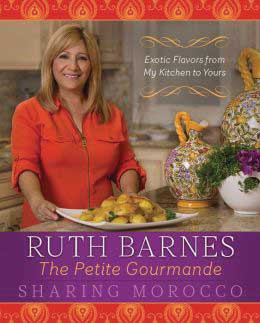
Sharing Morocco
Exotic Flavors From My Kitchen to Yours
Ruth BarnesGreenleaf Book Group Press
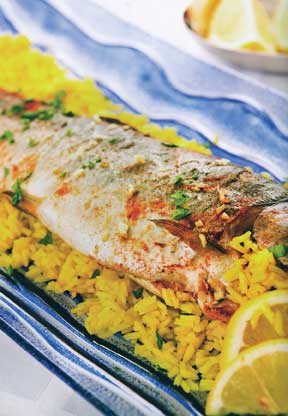 Baked Trout
Stuffed With Rice and Dates
Baked Trout
Stuffed With Rice and Dates
4 to 6 small trout, scaled, gutted and cleaned
1/2 teaspoon salt, plus additional
for seasoning the fish
1/2 teaspoon pepper, plus additional for seasoning the fish
2 cups uncooked long grain rice
4 teaspoons olive oil, plus extra for drizzling
2 large onions, diced
1/2 bunch parsley, chopped
1/2 bunch cilantro, chopped
2 tablespoons cinnamon
1 teaspoon ground ginger
1/2 teaspoon turmeric
(or a pinch of saffron)
2 cups dates, pitted and chopped
1/2 cup sliced, blanched almonds
2 lemons, cut into wedges, for garnish
Preheat the oven to 350 degrees.
Season the fish with salt and pepper.
Cook the rice according to the package directions and let it cool.
While the rice is cooking, heat the oil in a medium frying pan and sauté the onions on medium heat for 5 minutes or until translucent. Remove from the heat and let it cool.
Combine 1/2 cup of the rice with the onions, parsley, cilantro, cinnamon, ginger, turmeric, dates and almonds. Add the 1/2 teaspoon salt and 1/2 teaspoon pepper and mix well.
Spoon the rice stuffing into each fish cavity and drizzle oil over all the fish.
Wrap each fish in aluminum foil and place on a large baking tray.
Bake for 1 hour or until the fish is tender. (Test by gently inserting a fork into the flesh, which should begin to flake.) Unwrap the foil packages and place the fish on a large serving platter. Garnish with lemon wedges.
Serve on a bed of the remaining 1–1/2 cups of rice.
Makes 4 to 6 servings
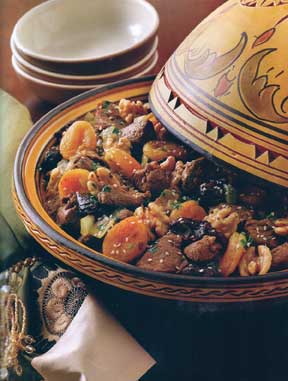 Lamb Tagine With Apricots and Prunes
Lamb Tagine With Apricots and Prunes
3 tablespoons olive oil
3 pounds boneless leg of lamb, trimmed of fat and cut into 1–inch cubes
1 large yellow onion, chopped
1 teaspoon cinnamon
2 teaspoons freshly grated ginger
1 teaspoon turmeric
1 teaspoon cumin
1/2 bunch cilantro, chopped
1 teaspoon salt
1/2 teaspoon pepper
1–1/2 cups low–sodium beef broth
3 tablespoons honey
1 cup dried apricots
1 cup dried, pitted prunes
1 tablespoon sesame seeds, for garnish
1/2 cup walnut halves, for garnish
In a cooking tagine or Dutch oven, heat the olive oil and brown the lamb on all sides. Remove the lamb to a platter.
Sauté the chopped onion for about 5 minutes, until it begins to soften. Return the meat to the pan and add the cinnamon, ginger, turmeric, cumin, cilantro, salt and pepper. Continue cooking for about 2 minutes.
Add the beef broth. Lower the heat, cover and simmer for 1 hour 15 minutes.
Stir in the honey, apricots and prunes, and cook for a further 15 minutes.
Remove the lamb and fruit from the tagine and place on a serving tagine or platter. Spoon the sauce over the meat and fruit.
Garnish with the walnut halves and sesame seeds.
Makes 4 to 6 servings